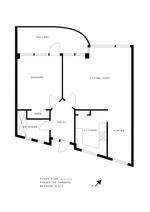Newburn Flats
| Newburn Flats | |
|---|---|
 | |
| General information | |
| Architectural style | Mid 20th century Expressionism |
| Address | 30 Queens Road |
| Town or city | Melbourne |
| Country | Australia |
| Completed | 1941 |
| Design and construction | |
| Architect | Frederick Romberg, Mary Turner Shaw |
| Architecture firm | Romberg & Shaw |
Newburn Flats is an apartment building located at 30 Queens Road, Melbourne. It is considered one of the first examples of European ideals in relation to multi-unit residences in Australia. It was designed by the firm Romberg & Shaw (Frederick Romberg and Mary Turner Shaw) and completed in 1941.
History
The 26-year-old Romberg had been in Melbourne for little more than a year when he embarked on the Newburn project. The site contained a derelict mansion Newburgh named after a town in Fife, Scotland owned by the Amess family. As a result of the uncertainty of the imminent war, Romberg with the help of Bernard Gore Brett set up Newburn Pty. Ltd with his Father In-law Dr. Sulzer’s investment and his own remaining assets.[1]
With the outbreak of war in September 1939 additional pressures were added to the Newburn Project. Whilst also working on the project Romberg remained at Stephensen and Turner, however as the project became more demanding of his time he had to make the decision to resign in order to fully concentrate on the project. In first year of operation he set up office in Collins Street, Melbourne with an associate Richard Hocking, calling the firm Romberg and Hocking. However Romberg was not yet a registered architect and had to subsequently sit two exams in professional practice and specifications before being recognised in Australia in May 1940. Hocking soon left the partnership after only a few months and Romberg invited another Stephensen and Turner employee, Mary Turner Shaw, also known as Mollie Turner Shaw. This partnership again lasted only a year with Romberg having to continue on the Newburn Project in solo practice.[2]
A building contract was signed in March 1940 at £18,625 however with additional fees including architect and land the total investment came to £29,000. The lowest tenderer was a builder named Jack Aird, a former boxer and punter and quite supportive of the young architect.[3]
Planning


The initial design was altered to increase the rental profit by twisting four of the flats to point towards Albert Park whilst adding an extra room and an additional rooftop garden. These four apartments were separated from the rest of the units by a glazed stairwell. The angular or staggered planning of the flats allowed greater privacy to its occupants whilst allowing an outlook to the extensive garden. This was also aided by the situation of the plan on the southern boundary and restricting all internal circulation to the southern balconies.[4]
Construction
The construction method used for the flats was new for Australian standards with the external walls constructed from stripped concrete a technique already much established in Switzerland. For formwork they used 600 square steel shutters and poured in 600 lifts whilst for the curved balconies and for variation in texture corrugated formwork was used.
Borrowing from the common practice in Swiss design to incorporate art, Romberg enlisted Gert Sellheim, a commercial artist with whom he had collaborated with for the New Zealand pavilion. Aside from the standard numbers on the door, Sellheim painted an individual aboriginal motif for each of the 25 flats and a colourful sundial on the external wall. Since they were prone to fading pigments and ongoing vandalism, when the flats were finally sold in 1957, the new owner had the motives painted over. Another significant feature was the individual colour scheme of the complex. Contrasting the creamy-white exterior walls were the small highlights of blue and yellow on the window frames and mullions, whilst the rear garage doors featured a bold blue-and-cream checkered pattern.[5]

Architectural importance
Completed in early 1941, the Newburn project was well received and considered one of the first Australian adaptions of European ideals in relation to multi-unit complexes. With an offset plan reminiscent of Gropius's Berlin housing estate and key design elements related to the Expressionism of Erich Mendelsohn. It was considered the first Australian residential design to use form concrete as a finished exterior surface as opposed to the common practice of stuccoed brickwork. There have been subsequent alterations apart from finishes and fittings; the rooftop pergola was replaced by a penthouse in the 1950s, and, perhaps more importantly, the building was subdivided in the 1970s. Despite this the building remains structurally in good condition.[6]
References
- ↑ Frederick Romberg’s Personal Diary – RMIT Design Archives
- ↑ mams.rmit.edu.au/achdfm6zbqwo.pdf
- ↑ Frederick Romberg’s Personal Diary – RMIT Design Archives
- ↑ Victorian Heritage Database: Newburn Flats
- ↑ http://www.architecture.com.au/i-cms_file?page=220/VIC-NewburnFlats.pdf
- ↑ http://www.architecture.com.au/i-cms_file?page=220/VIC-NewburnFlats.pdf
External links
- RMIT Design Archives
- Australian Institure of Architecture
- Victorian Heritage Database: Newburn Flats
- Design Archives PDF
Coordinates: 37°50′34″S 144°58′33″E / 37.842861°S 144.975866°E